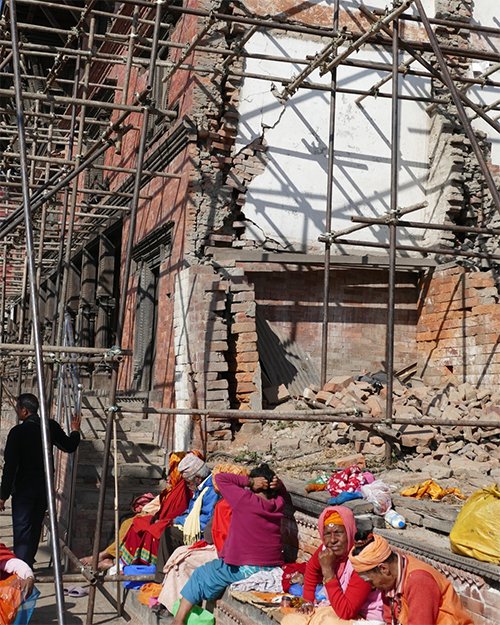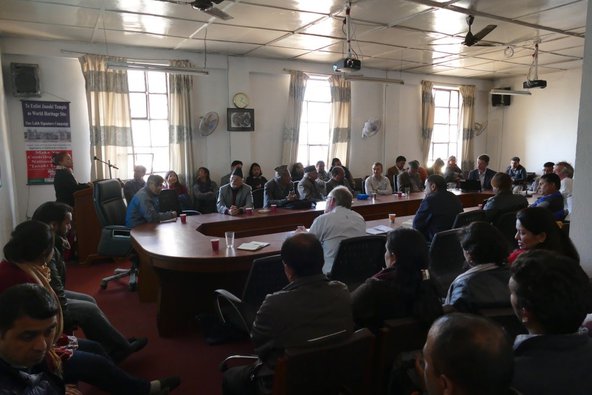Reducing Disaster Risk to Life and Livelihoods by Evaluating the Seismic Safety of Kathmandu's Historic Urban Infrastructure
- Project status
- Closed
- Programmes
- Cities & Infrastructure
- Departments
- International
Kathmandu’s medieval cities and shrines are exceptional architectural and artistic achievements with traditions of seismic adaptation. They host urban infrastructure of tangible and intangible value, play vital roles of cohesion in the lives of thousands, and represent portals where the heavens touch earth and people commune with guiding deities. Generating 7.6% GDP through tourism, Kathmandu’s iconic skyline was dramatically altered by the Gorkha Earthquake in 2015. Losses included 9,000 killed, 20,000 injured and the destruction of 500,000 homes. A total of 691 historic monuments across Nepal were damaged, of which 131 collapsed causing death and injury, with an associated 32% cancellation of tourist visits. This interdisciplinary North-South partnership contributes to SDG17 by co-producing and disseminating a methodology to assess, evaluate and improve the seismic safety of historic urban infrastructure within Kathmandu's World Heritage sites, reducing direct risk to life and livelihoods and damage of gains towards SDG11, while preserving Kathmandu’s authenticity and traditions.

The earthquake damaged 403 monuments in Kathmandu’s historic urban infrastructure (Gautam 2015). Their collapse caused multiple fatalities and first responders demolished others, fearing that they might also fall (Coningham 2016). Fences were built around damaged shrines, separating devotees from intangible foci. With Official Development Assistance (ODA) pledges of $2.5 billion, Nepal’s Government has approved the rehabilitation of Kathmandu’s historic infrastructure, but there is tension between Sendai’s Build Back Better framework and the obligation to preserve the authenticity and intangible values of its UNESCO sites.
Many risk-reduction strategies are demolishing buildings and rebuilding them in modern materials; while others have been hybridised with metal bracing (Weise 2016). Mud mortars are frequently being replaced by cement/limes, although the resultant inflexibility is not necessarily advantageous for seismic resilience. Justified by expediency and cost, contracts go to lowest tenders, despite a lack of expert capacity. Monuments are rebuilt without analysis of why they collapsed and their foundations, which preserve sequential experimental adaptations offering examples of practical seismic-resistant foundations which could be applied to other structures, are demolished without record (Coningham 2017). With donor liability fears, contractors privilege modern materials, despite successful histories of vernacular systems (Shakya 2012). Costly historic bricks are landfilled, causing supply chain delays and environmental impact from kilns. Residents, craftspeople and tour operators/business are frequently excluded from decisions but risk to them, and their livelihoods, remains.
This interdisciplinary North-South partnership contributes to the United Nations Strategic Development Goal 17 by co-producing and disseminating a methodology to assess, evaluate and improve the seismic safety of historic urban infrastructure within Kathmandu's World Heritage sites, reducing direct risk to life and livelihoods and damage of gains towards SDG11, while preserving Kathmandu’s authenticity and traditions.
This project builds upon previous British Academy-sponsored archaeological research at Pashupati, and within the wider urban environment of UNESCO, National Geographic and AHRC-GCRF sponsored rescue archaeology in post-earthquake Kathmandu, but now integrates archaeology and geoarchaeology with 3D visualisation and geotechnical and structural engineering.
The research team will co-produce a ‘heritage ecosystem’ approach by combining geotechnical and structural engineering with (geo)archaeological outcomes from two post-disaster missions at seven monuments within Kathmandu. It will assess historic construction practice and traditional construction ability, and map these onto rebuild initiatives with the objective of improving, and where appropriate, blending, with modern low-interventionist retrofitting strategies. The team will also analyse construction materials (introduced cultural soil foundations, brick/mortar and timber attributes), augmented by re-analysis of soil cores to model site amplification/earthquake motion. As many superstructure plans are incomplete, it will generate 3D reconstructions from Multi-View Stereo/Structure-From-Motion photogrammetry with other contextual information integrated into a modified Potree viewer, combining extant photographic records, crowd-sourced imagery and web-scraping. Vernacular system partners will contribute to the evaluation of seismic performance, damage and progressive deterioration from shock and aftershock sequences. The team will also evaluate maintenance flaw impacts and timber failure patterns compiled during earlier missions. In addition it will sample residents, craftspeople, tour operators and businesses to map and promote each monument’s traditional processes of procurement, construction, recycling and maintenance, and their intangible value as well as patterns of visitor spend and behaviour. It will then select a sample of three monuments to conduct more detailed building and ground-penetrating radar surveys to evaluate the foundation depth and seismic vulnerability (and to ensure consistency with analysis of geotechnical core) before proving expertise to government, donors and contractors on rebuild strategies that require minimalist interventions. Finally, the monuments will be attributed risk values and prioritised for maintenance and/or reconstruction and a revised methodology will be shared and disseminated.

Principal Investigator: Professor Robin Coningham, Durham University
Co-Investigators: Professor Ian Simpson, University of Stirling; Dr Andrew Wilson, University of Bradford; Professor David Toll, Durham University; Dr Paul Hughes, Durham University; Dr Vasilis Sarhosis, Newcastle University; Dr Sean Wilkinson, Newcastle University